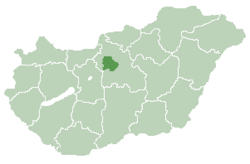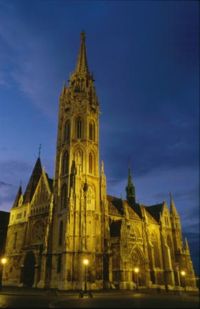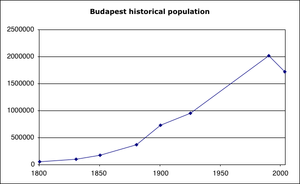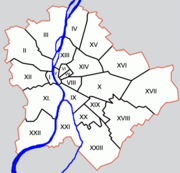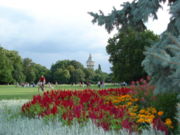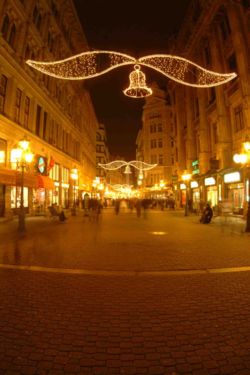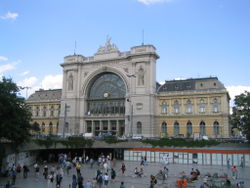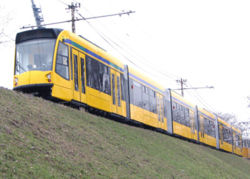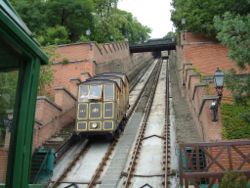Budapest
2007 Schools Wikipedia Selection. Related subjects: European Geography
| Budapest | |||||
|
|||||
| Nickname: "Paris of the East", "Pearl of the Danube" or "Queen of the Danube" |
|||||
| Location of Budapest in Hungary | |||||
| Country | Hungary | ||||
|---|---|---|---|---|---|
| County | Pest | ||||
| Mayor | Gábor Demszky ( SZDSZ) | ||||
| Area | |||||
| - City | 525,16 km² | ||||
| - Land | n/a km² | ||||
| - Water | n/a km² | ||||
| Population | |||||
| - City (2006) | 1,695,000 | ||||
| - Density | 3570/km² | ||||
| Time zone | CET ( UTC+1) | ||||
| - Summer ( DST) | CEST ( UTC+2) | ||||
| Website: budapest.hu | |||||
Budapest ( pronounced [ˈbʊdɑpɛʃt]) is the capital city of Hungary and the country's principal political, cultural, commercial, industrial and transportation centre.
Budapest has approximately 1.7 million inhabitants, down from a mid- 1980s peak of 2.1 million. Budapest became a single city occupying both banks of the river Danube with the amalgamation on 17 November 1873 of right-bank (west) Buda (Ofen in German) and Óbuda (Old Buda or Alt-Ofen) together with Pest on the left (east) bank. It is the seventh largest city in the European Union.
History
Budapest's recorded history begins with the Roman town of Aquincum, founded around AD 89 on the site of an earlier Celtic settlement near what was to become Óbuda, and from 106 until the end of the 4th century the capital of the province of lower Pannonia. Aquincum was the base camp of Legio II Adiutrix. The area of Campona (today's Nagytétény) belongs to Buda as well. Today's Pest became the site of Contra Aquincum (or Trans Aquincum), a smaller sentry point. The word Pest (or Peshta) is thought to originate from the Bolgar language, (thought to be a Turkic language, not related to modern Bulgarian, which is a Slavic language) because at the time of the reign of the Bulgarian Khan Krum (approximately 796- 814), the town was under Bulgar dominion. The area then became a homeland for the Avars and some Slavic peoples.
The area was occupied around the year 900 by the Magyars of Central Asia, the cultural and linguistic ancestors of today's ethnic Hungarians, who a century later officially founded the Kingdom of Hungary. Already a place of some significance, Pest recovered rapidly from its destruction by Mongol invaders in 1241, but it was Buda, the seat of a royal castle since 1247, which in 1361 became the capital of Hungary.
The Ottoman Empire's conquest of most of Hungary in the 16th century interrupted the cities' growth: Buda and Pest fell to the invaders in 1541. While Buda remained the seat of a Turkish pasha, and administrative centre of a whole vilayet, Pest was largely derelict by the time of their recapture in 1686 by Austria's Habsburg rulers, who since 1526 had been Kings of Hungary despite their loss of most of the country.
It was Pest, a bustling commercial town, which enjoyed the faster growth rate in the 18th and 19th century and contributed the overwhelming majority of the cities' combined growth in the 19th. By 1800 its population was larger than that of Buda and Óbuda combined. The population of Pest grew twenty-fold in the following century to 600,000, while that of Buda and Óbuda quintupled. The fusion of the three cities under a single administration, first enacted by the Hungarian revolutionary government in 1849 but revoked on the subsequent restoration of Habsburg authority, was finally effected by the autonomous Hungarian royal government established under the Austro-Hungarian Ausgleich ("Compromise") of 1867; see Austria-Hungary. The total population of the unified capital grew nearly sevenfold in 1840– 1900 to 730,000.
During the 20th century, most population growth occurred in the suburbs, with Újpest more than doubling between 1890– 1910 and Kispest more than quintupling in 1900– 1920, as much of the country's industry came to be concentrated in the city. The country's human losses during World War I and the subsequent loss of more than two thirds of the former kingdom's territory (1920) dealt only a temporary blow, leaving Budapest as the capital of a smaller but now sovereign state. By 1930 the city proper contained a million inhabitants, with a further 400,000 in the suburbs.
Towards the end of World War II in 1944 Budapest was partly destroyed by British and American air raids. The following siege lasted from December 24 1944 to February 13 1945, and major damage was caused by the attacking Soviet and defending German and Hungarian troops. All bridges were disrupted by the Germans. More than 38,000 civilians lost their lives during the fighting. Between 20% and 40% of Greater Budapest's 250,000 Jewish inhabitants died through Nazi and Arrow Cross genocide during 1944 and early 1945. , Despite this, Budapest today has the highest number of Jewish citizens per capita of any European city.
On January 1, 1950, the area of Budapest was significantly expanded: new districts were formed from the neighbouring cities and towns (see Greater Budapest). From the severe damage during the Soviet siege in 1944, the city recovered in the 1950s and 1960s, becoming to some extent a showcase for the more pragmatic policies pursued by the country's communist government ( 1947– 1989) from the 1960s. Since the 1980s, the capital has shared with the country as a whole in increased emigration (mostly to the agglomeration) coupled with natural population decrease.
Demographic history
Population:
- 1800: 54,200
- 1830: 102,700
- 1850: 178,000
- 1880: 370,800
- 1900: 733,400
- 1910: 882,000
- 1925: 957,800
- 1990: 2,016,100
- 2003: 1,719,343
Politics
Budapest is the centre of all political affairs, with most countries' embassies located in the city. – It has recently been the location of protests and violent riots, see 2006 protests in Hungary.
Districts
Originally Budapest had 10 districts after coming into existence upon the unification of the three cities in 1873. On 1 January 1950 Budapest was united with several neighboring towns and the number of its districts was raised to 22. At that time there were changes both in the order of districts and in their sizes. Now there are 23 districts, 6 in Buda, 16 in Pest and 1 on Csepel island between them. Each district can be associated with one or more city parts named after former towns within Budapest.
Islands
Seven islands can be found on the Danube: Hajógyári sziget (literal translation: Shipyard Island), Margitsziget (Margaret Island), and Csepel sziget (this island is a separate district of Budapest, the XXI., while the other islands are parts of other districts, the III. and XIII. respectively), Palotai-sziget (in fact, it's a peninsula today), Népsziget (connected to the above, but mostly surrounded by water), Háros-sziget and Molnár-sziget.
Notable islands:
- Margitsziget is a 2.5 km long island (and 0.965 km² in area) The island mostly consists of a park and is a popular recreational area for tourists and locals alike. The island lies between bridges Margaret Bridge (south) and Árpád Bridge (north). Dance clubs, Swimming pools, an Aqua park, athletic and fitness centers, bicycle and running tracks can be found around the Island. During the day the island is occupied by people doing sports, or just resting. In the summer (generally on the weekends) mostly young people go to the island at night to party in its terraces, or to just 'chill' with a bottle of alcohol on a bench or on a grass (this form of entertainment is sometimes referred to as bench-partying)
- The Csepel-sziget (pronounced CHE-pel see-get) or Csepel Island is the largest island of the River Danube in Hungary. It is 48 km long; its width is 6-8 km and its area comprises 257 km², whereas only the northern tip is inside the city limits.
- Hajógyári-sziget (or Óbudai-sziget) is a man built island, located in the third district. This island hosts many activities such as: wake-boarding, jet-skiing during the day, and dance clubs during the night. This is the island where the famous Sziget Festival takes place, hosting hundreds of performances per year and now around 400,000 visitors in its last edition. Many building projects are taking place to make this island into one of the biggest entertainment centers of Europe, the plan is to build Apartment buildings, hotels, casinos and a marina.
- Luppa-sziget is the smallest island of Budapest, located in the north region.
Landmarks and monuments
- (The below sights are grouped by location.)
- Andrássy Avenue with its several sights including the State Opera House, the Pest Broadway and the House of Terror
- Buda Castle with the Royal Palace, the Funicular, Hungarian National Gallery and National Széchényi Library, Matthias Church, Holy Trinity Column (a plague column) and Fisherman's Bastion
- City Park with Széchenyi Medicinal Bath, Vajdahunyad Castle, the Timewheel, the Zoo, the Municipal Grand Circus and the Amusement Park
- Danube Promenade (Duna-korzó) with Vigadó Concert Hall
- Ferenciek tere with Paris Courtyard and Erzsébet Bridge with Inner City Parish Church nearby
- Franz Liszt Academy of Music
- Gellért Baths, Gellért Hill with Gellért Statue, Cave Church and Citadel with Liberty Statue
- Geological Museum
- Great Market Hall and Liberty Bridge
- Heroes' Square with the Millenary Monument, the Palace of Art and the Museum of Fine Arts
- Margaret Island with the Centennial Memorial, a Japanese garden, a Musical Fountain, several recreation facilities and Franciscan, Dominican and Premonstratensian ruins from the Middle Ages
- Museum of Applied Arts
- National Museum
- New York Café
- Dohány Street Synagogue with the Holocaust Memorial ( weeping willow statue)
- Óbuda
- Palace of Arts and National Theatre
- Parliament Building with King Stephen's crown and sceptre, Kossuth Memorial, Ethnographical Museum, Attila József statue, Imre Nagy statue
- Saint Stephen's Basilica
- Statue Park
- Széchenyi Chain Bridge, Academy of Sciences and Gresham Palace
- Tomb of Gül Baba
- Váci Street and Vörösmarty Square
- Western Railway Station
Tourism
|
A cow at the 2006 Cow Parade |
Heroes' Square |
The Parliament |
|
|
St. Stephen Basilica |
House of Terror |
Shopping
Budapest has the most shopping centers in Europe, including WestEnd City Centre, the largest shopping centre in Central and Eastern Europe, and the biggest Tesco and Auchan hypermarkets in the world. The Great Market Hall is a large indoor market and a major tourist attraction.
All luxurious brands can be found, on the high streets, such as Andrássy Avenue and Váci utca.
Transport
Airport
Budapest Ferihegy International Airport, which has 3 different passenger terminals: Ferihegy 1, which tends to serve the many discount airlines now flying to and from Budapest, Ferihegy 2/A and Ferihegy 2/B. Terminal 2/C is planned to be built. The airport is located to the east of the centre in the XVIII. district in Pestszentlőrinc. Malév (Hungarian Airlines) began to change its aircraft in 2003, and by 2005 owned the most modern fleet in Europe.
Roads
Budapest is the most important Hungarian road terminus; all the major highways end there. Between 1990-1994, the city Street names were reverted from the names given under Soviet occupation back to their late-19th century names. Budapest is also a major railway terminus.
Commuting with public transport
Budapest public transport is mainly provided by BKV, the company operates Buses, Trolley Buses, Trams, Suburban Railway lines, the Metro, Boats and many other special vehicles. Budapest's tramline is the busiest traditional city tram line in the world, with 50-metre long trains running at 60 to 90 second intervals at peak time and usually packed with people. Night traffic service is outstandingly good.
Special vehicles
Beside metros, suburban rails, buses, trams and boats, there are a couple of less usual vehicles in Budapest:
- trolleybus (trolibusz) on several lines in Pest
- funicular (sikló) between the Chain Bridge and Buda Castle
- cyclecar (bringóhintó) for rent in Margaret Island
- chairlift (libegő)
- cog-wheel railway (fogaskerekű vasút)
- children's railway (gyermekvasút)
The latter three vehicles run among Buda hills.
Railway
Main articles: MÁV, HÉV Hungarian main-line railways are operated by MÁV. There are three main railway termini in Budapest, Keleti (eastern), Nyugati (western), and Déli (southern), operating both domestic and international rail services. Budapest was one of the main stops of the Orient Express until 2001, when the service was cut back to Paris-Vienna.
There is also a suburban rail service in and around Budapest, operated under the name HÉV.
Waterways
The river Danube flows through Budapest on its way to the Black Sea. The river is easily navigable and so Budapest has historically been a major commercial port (at Csepel).
International schools
Many embassies and transnational companies are located in Budapest. They bring many expatriate foreigners and their families to town, creating demand for private and international schools. These schools are usually quite expensive and are attended by the expatriates as well as some richer Hungarians.
List of international schools:
- American International School of Budapest - Homepage
- International School of Budapest - Homepage
- International Christian School of Budapest - Homepage
- Greater Grace International School - Homepage
- British International School, Budapest - Homepage
- Budapest University of Technology and Economy International Secondary School - Homepage
- Britannica International School - Homepage
- SEK International School Budapest - Homepage
- McDaniel College Budapest - Homepage
- Lauder Javne Jewish Community School and Kindergarten - Homepage
- Budapest French School (Lycée Gustave Eiffel) - Homepage
- Austrian-Hungarian European School - Homepage
- Thomas Mann Gymnasium / Deutsche Schule Budapest - Homepage
- Japanese School of Budapest - Homepage
Notable people from Budapest
- Franz Xaver von Zach 1754 born in Pest, astronomer
- Ignaz Semmelweis (Semmelweis Ignác Fülöp) born 1818 in Buda, physician
- Árpád Doppler born in 1857 in Budapest, composer
- Theodor Herzl born in 1860 in Budapest, journalist and founder of modern political Zionism
- Theodore von Karman born in 1881 in Budapest, pioneer of modern aerodynamics and fluid dynamics
- George de Hevesy (Hevesy György) born in 1885 in Budapest, Nobel Prize winner in chemistry (1943)
- Georg Lukács (Lukács György) born in 1885 in Budapest, philosopher
- Michael Curtiz (Kaminer Manó Kertész) born in 1886 in Budapest, film director, among other things directed "Casablanca"
- Fritz Reiner born in 1888 in Budapest, conductor
- Albert von Szent-Györgyi Nagyrapolt born in 1893 in Budapest, Nobel Prize winner biologist, first isolated and described the vitamin C
- Karl Mannheim (Mannheim Károly) in 1893 in Budapest, philosopher
- George Szell (Széll György) born in 1897 in Budapest, conductor
- Leó Szilárd born in 1898 in Budapest, developed the nuclear bomb
- Béla Bartók lived from 1899 to 1940 in Budapest, composer
- László József Bíró born in 1899 in Budapest, developed the biro
- Edward Teller (Teller Ede) born in 1908 in Budapest, "father of the hydrogen bomb" nuclear physicist
- Sir Georg Solti (Stern György) born in 1912 in Budapest, conductor
- Amrita Sher-Gil born in 1913 in Budapest, painter
- László Papp born in 1926 in Budapest, boxer
- Ferenc Puskás born in 1927 in Budapest, football player
- Tom Lantos (Lantos Tamás Péter) born in 1928 in Budapest, US Congressman
- Imre Kertész born in 1929 in Budapest, author, Nobel Prize 2002
- István Kertész born in 1929 in Budapest, conductor
- George Soros (Soros György) born in 1930 in Budapest
- Andy Grove (Gróf András István) born in 1936 in Budapest, founder of Intel Corporation
- Ernő Rubik born in 1944 in Budapest, developed Rubik's Cube
- Péter Esterházy born in 1950 in Budapest, author
- János Sebestyén born in 1931 in Budapest, organist and harpsichordist
- Zoltán Kocsis born in 1952 in Budapest, pianist
- Zoltán Kodály lived and died 1967 in Budapest, composer
- Pál Erdős born in 1913 in Budapest, mathematician
- Robert Capa born 1913, grew up in Budapest, reporter, photographer
- Eugene Wigner "the silent genius" born and raised in Budapest, was a Hungarian physicist and mathematician who received the Nobel Prize in Physics in 1963
- John von Neumann Hungarian mathematician and polymath who made contributions to quantum physics, functional analysis, set theory, economics, computer science, topology, numerical analysis, hydrodynamics (of explosions), statistics and many other mathematical fields as one of world history's outstanding mathematicians.
Sister cities
|


